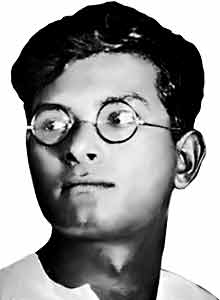 Manik Bandyopadhyay was born on 19 May in the year 1908. During the short span of his life he produced forty two novels and more than two hundred short-stories. He was born in a small town of Dumka in Santal Paragona district of Bihar. He passed his Entrance examination from the Midnapore Zilla School. He did his graduation in science from Presidency College. Some of his important contributions include: `Padma Nadir Majhi`, `Putul Nacher Etikatha` and `Chatushkone`. The writer was married to Kamala Devi.
Manik Bandyopadhyay was born on 19 May in the year 1908. During the short span of his life he produced forty two novels and more than two hundred short-stories. He was born in a small town of Dumka in Santal Paragona district of Bihar. He passed his Entrance examination from the Midnapore Zilla School. He did his graduation in science from Presidency College. Some of his important contributions include: `Padma Nadir Majhi`, `Putul Nacher Etikatha` and `Chatushkone`. The writer was married to Kamala Devi.
He worked as an editor for Nabarun magazine for few months. Thereafter he also worked as an editor of Bangasree, a literary magazine. In 1939 he established a printing and publishing house. He also served the government of India as Publicity Assistant in 1943.
He died at a young age of 48 in the year 1956. He had struggled with poverty and epilepsy.
He first wrote a story `Atshi mami` in `Bichitra` paper. His stories were published in various Bengali literary magazines like Bichitra, Bangasree, Purbasha, AnandaBazaar Patrika, Jugantor, Satyajug, Probashi, Desh, Chaturanga, NoroNari and many more.
Style of Manik Bandyopadhyay
His compositions dealt with the pettiness of existence in the context of a village. He was concerned with the dark side of the human mind. In his novel `Putulnacher Etikatha` he focussed on the hypocrisy in villages. The publishing of `Diba-Ratrir Kabya` in 1935 and `Padma Nadir Majhi` and `Putul Nacher Itikotha` in 1936 made him one of the most notable novelists since Bankim Chandra, Rabindranath and Sarat Chandra. He focussed on the life of ordinary rural and urban people accompanied with a neat narrative. His fiction was based on human mind. His earlier works had a Freudian approach. He was influenced by Marxist theory.
Literary works of Manik Bandyopadhyay:
| Janani | Pesha | Pragoitihashik | Lekhoker Katha(Essay) |
| Diba-Ratrir Kabya | Swadhinotar Swad | Mihi O Mota Kahini | Diner kobita(poem) |
| Padma Nadir Majhi | Pashapashi | Sarisrip | Raater kobita(poem) |
| Putul Nacher Itikatha | Sarbojonin | Bou | Dibaraatrir kabyo(poem) |
| Jiboner Jotilota | Nagpash | Shamudrer Swad | Uttor dokkhin(poem) |
| Ahinsa | Feriwala | Bhejal | Gaachtolae(Poem) |
| Dhorabandha Jiban | Arogya | Holudpora | Buro santrasbadi(poem) |
| Chatushkone | Chalcholon | Poristhiti | Cha(poem) |
| Protibimbo | Haraf | Khotian | Prothom kobitar kahini(poem) |
| Drapan | Holud Nodi Sobuj Bon | Matir Mashul | Raja o proja (poem) |
| Shorobasher Itikotha | Mashul | Choto Boro | Sundor(Poem) |
| Chinha | Majhir Chele | Lajuklota | Shrabon maas(poem) |
| Jiyonto | Atashi Mami | Bhite-Mati(Play) | Kishori(poem) |
| Mod je khae se metal(poem) | Nastiker kotha(poem) | Rupkotha(poem) | Hae go hae(poem) |



















